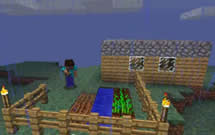Gaming, including Minecraft, has important implications for students
 Gaming is gaining more and more momentum in education, and one of the most popular games today is Minecraft, which educators are using in innovative ways in classrooms across the country.
Gaming is gaining more and more momentum in education, and one of the most popular games today is Minecraft, which educators are using in innovative ways in classrooms across the country.
Minecraft is a “sandbox” game that includes game-like components but offers users flexibility to build the game in any way they desire. The game offers different modes and approaches and is highly modifiable and flexible.
Though the game itself is popular, using it in classrooms based only on its popularity won’t work magic on students. But following best practices and a few important rules can help increase student engagement, said Marianne Malmstrom, cognitive architect at The Elisabeth Morrow School (N.J.). The school’s students used Minecraft to design their own game, Escape to Morrow, which they have been playing in–and out–of classrooms for three years.
(Next page: Minecraft’s potential for learning)
“It’s a deceivingly simple game…but it’s also endlessly complex,” Malmstrom said.
Instead of implementing the latest game, Malmstrom recommends that educators follow the learning. “I think it’s really scary for teachers to let go of the norm,” she said.
Massively Minecraft, an Australia-based group, recommends that teachers spend time playing the game with students before using it in any educational capacity.
The game began in the summer of 2012 and students in grades 3-8 played throughout the year, during auxiliary programs and also during school. In all, the game went through seven iterations.
Student feedback–both student-to-teachers and student-to-student feedback–proved invaluable.
“It really, at the end of the day, is not about the game. It really is about an approach to understand learning and how we fold that back into school,” Malmstrom said.
At Elisabeth Morrow, students are crafting community norms through the games, Malmstrom said. “Citizenship is not taught, it’s practiced–and you have to be in the environment to practice it,” she noted.
One surprising byproduct of incorporating Minecraft is students’ desire to create games within the games.
“That’s what made me think, ‘That’s how I want to build curriculum’–I want to take that desire they have to make games and fold that into the curriculum,” Malmstrom said.
The game started with a question: “Could we create a game that could be played with other classes or schools asynchronously?”
Students’ objectives were to share resources to solve a problem, with the following constraints: Three different nations had an epic problem–an impending natural disaster–and had limited resources with which to solve it.
Giving students a limited number of constraints urged them to be more creative than giving them a blank slate, Malmstrom said.
Teachers found that when they took too much control over the game, it stifled students’ creativity.
“When we step in as a teacher, we’re taking the opportunity for ownership [away],” Malmstrom said, adding that when things are student-led, there’s much more room for engagement and growth.
Carolyn Bliesener, a fifth grade teacher at Elisabeth Morrow, integrated the game into her class in January after sitting in on another class and observing how it inspired students.
The game the school created fit in perfectly with the fifth grade’s overarching focus on self-organization, and it also aligned perfectly with units on different forms and processes of government.
“The discussions that are generated by playing this game and having them figure out themselves…have been truly fascinating,” Bliesener said.
“It’s always a teacher’s desire that when the children leave a lesson, that it sticks with them. Whenever we play Minecraft I can hear the children walking down the hallway to their next class and they’re still talking about the game.”
Click here to learn more about how the Elisabeth Morrow School has implemented Minecraft.
- A look at AI use in schools across the country - November 18, 2024
- 5 ways your classroom environment boosts student engagement - November 14, 2024
- Federal toolkit targets safe, ethical AI use in classrooms - November 11, 2024

